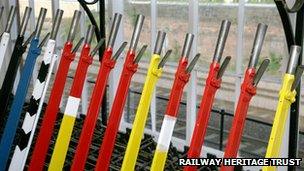Signal box: End of the line for 'much-loved' building?
- Published
They are as much a part of Britain's landscape as red telephone boxes but the signal box, the building from which train routes are managed, is approaching the end of the line.
Network Rail, the company which manages the UK's rail infrastructure, is replacing the remaining 800 signalling locations with 14 route operating centres as part of an overhaul of the system.
The project is expected to take up to 30 years and will cover England, Wales and Scotland. About 80% of the new system is estimated to be in place within the next 15 years
As part of the overhaul, English Heritage has carried out a review, external of operational signal boxes and those in heritage railways and museums in England to identify those boxes that might be worth preserving.
'Much-loved feature'
The public body's designation department will shortly begin the process of assessing those identified in the report for possible listing.
Andy Savage, executive director of the Railway Heritage Trust, which has funded the restoration of some of those already listed, said: "Signal boxes have been a much-loved feature of our railways for about a century and a quarter.
"However, their time is almost over - only some 500 remain on Network Rail (in England), compared with over 10,000 at the end of the Second World War, and they are rapidly being replaced by modern systems.
"Fortunately, many signal boxes are readily moveable, and have either been relocated to heritage railways, or taken for other uses - artists' studios, club houses, garden sheds or museums.
"So it will remain possible to see these structures doing what they were designed for, or as part of a community's assets, long after Network Rail's need for them is over."

Signal boxes contain some features which are found in all of them whatever their design
The buildings range from one-man "gate boxes", where a signalman opens and closes level crossing gates either manually or by pressing buttons, to large control centres which cover hundreds of miles of track.
Chris Denham, spokesman for Network Rail, said: "Consolidating all our signalling operations has a variety of advantages and they are not just economic - although it will save £250m a year.
"New signal equipment is more reliable and robust, which means fewer delays for passengers, but it also allows us to bring all our railway operations together in one place.
"For instance, train operators will be able to share our railway operating centres with the signallers that control hundreds of miles of track and be able to deal with problems as they arise. This means they can resolve issues much quicker and in some cases stop them arising altogether.
"For many passengers it will mean their train will be under the control of the same centre for its entire journey, watched over by computers that can automatically set its route, with signallers watching to take over if needed."
He added the new technology will also allow them to run more trains to overcome capacity constraints.
The English Heritage review was carried out by John Minnis, a specialist in railway architecture and a senior investigator for the organisation.
He said many signal boxes had already been listed but Network Rail's infrastructure programme had added impetus to reviewing which others should be protected.

St Albans South signal box in Hertfordshire was constructed in 1892 for the Midland Railway
Mr Minnis said there are a number of reasons for their popularity.
"They're very attractive buildings, on the one hand they are essentially quite utilitarian with similarities - they are small two-storey buildings with large windows in the top room above the locking room with the apparatus below - they've all got that in common. But there are so many variations on that theme," he said.
"They are in the public eye because they tend to be quite near stations so they are architecturally elaborate.
"Some of them are from the 1880s and 90s, they were built for a purpose that they are still used for today so they are remarkable survivors."
He added: "There is a passion for these buildings, not just from railway enthusiasts, they are quite prominent local landmarks, we are used to them being there and people will be sorry to see them go."
- Published8 July 2012
- Published17 May 2012
- Published23 April 2012